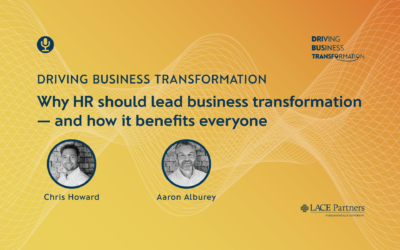In our latest blog we talk to Cathy and Rachel from LACE Partners about the complexities of change management during HR transformation. This is a summary of the discussion from the recent HR on the Offensive podcast.
What do we mean when we talk about change in a HR transformation context?
HR transformation programmes focus on improving the efficiency and effectiveness of the HR function. This can include shifting the operating model i.e. the way is the function is structured such as creating HR shared services, fundamentally changing the services HR provides and/or the implementation of HR systems.
Why is HR transformation so complex?
HR transformation programmes can be particularly complex as they impact every single member of the workforce. That is also often not just the permanent employees but also contingent workers. You are asking everyone – employees, line managers, leaders – to behave differently across a broad range of activities (how they contact HR, how they manage their teams, how they plan their workforce, etc).
Change management is a ‘contact sport’ and people go through their own change curves differently. That, combined with the multiple change impacts, means a structured and co-ordinated approach to change management is required.
The importance of personas
Using change ‘persona’ helps to consider how the change affects groups of people differently and how the change may need to be managed differently as a result. Sometimes HR transformation programmes can be too inwardly focused on the HR function and not sufficiently focused on the business personas involved so having a full range of persona is important. Within the business, core persona include business leaders, people managers and employees.
Within HR, core persona include HR business partners, HR generalists, centres of excellence/expertise and HR shared services. Then there are other support function personas which will also be impacted e.g. IT, Legal, Finance, etc.
Every organisation then has additional ‘lenses’ to apply to the persona groups reflecting the way the business is organised. Geography is a good example, e.g. how employees need to be supported through the change in France may be quite different to how employees in similar roles may be best supported in the US or the UK. Business units or divisions is another ‘lens’ – working practices may vary widely which then impacts the way the change needs to be managed.
Too many personas?
Always challenge yourself on the purpose of your persona set, because if you have too many personas you will be adding layers of unnecessary complexity. The purpose of a persona is to help you understand the change impacts and change support requirements and how these differ. Each persona group will have different concerns, questions and experiences as they go through the change. As well as informing the change approach, personas are developed to shape the experience design and can double up for both purposes as long as both sets of considerations are incorporated in a co-ordinated way.
The line manager challenge
Line managers can be one of the toughest persona groups to bring on board during an HR transformation, particularly if you are digitising HR services and looking for them to undertake an increased level of self-service, which they may consider to be “HR’s job”. Actively managing and supporting their change journey is vital, including being able to address concerns such as “Why do I have to do things differently when it was working fine before?” or “How can I manage my team effectively using this new technology?”.
Getting line managers on board is essential because they are such a critical influencer on the success of your HR transformation programme. It can be helpful to consider a staged approach to releasing new functionality or services. By choosing functionality for the first release that focuses on known pain points or processes which are core to the persona groups (e.g. approving absence, tracking team information) you can encourage early adoption.
Lead the change locally
Whilst HR often leads the messaging of the change, we recommend that local leaders are actually front and centre which means they need to be bought into the programme so they can lead it authentically. It is important for HR to stand up and explain why the change is needed from a HR perspective (particularly for the HR population and the line managers they will be supporting), but it is also important for business leaders to advocate the change, to be pivotal in delivering the message and lead by example.
If you’d like to discuss how your business can successfully navigate change through its HR transformation you can reach out to Cathy, or contact us directly here and we’d be happy to help.






